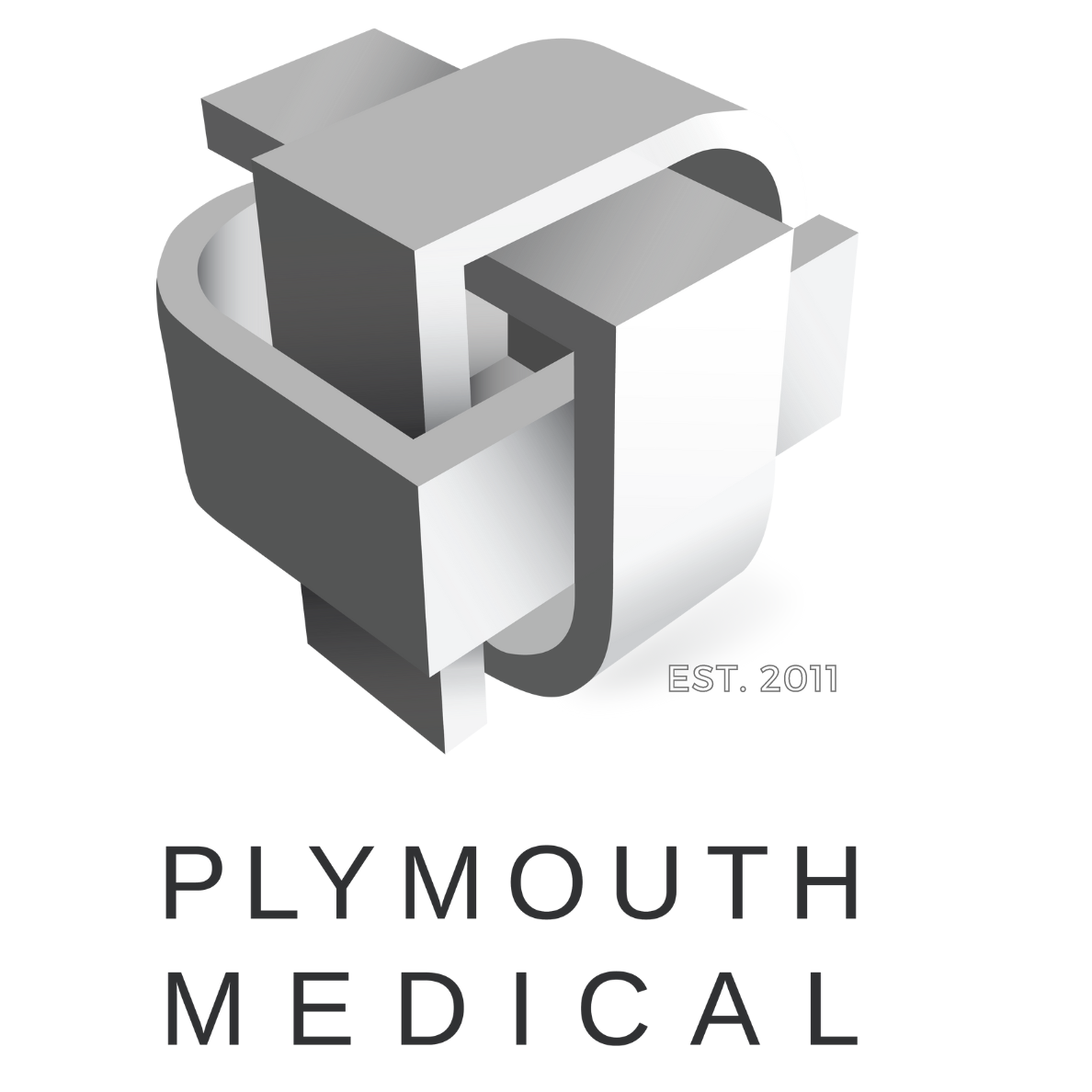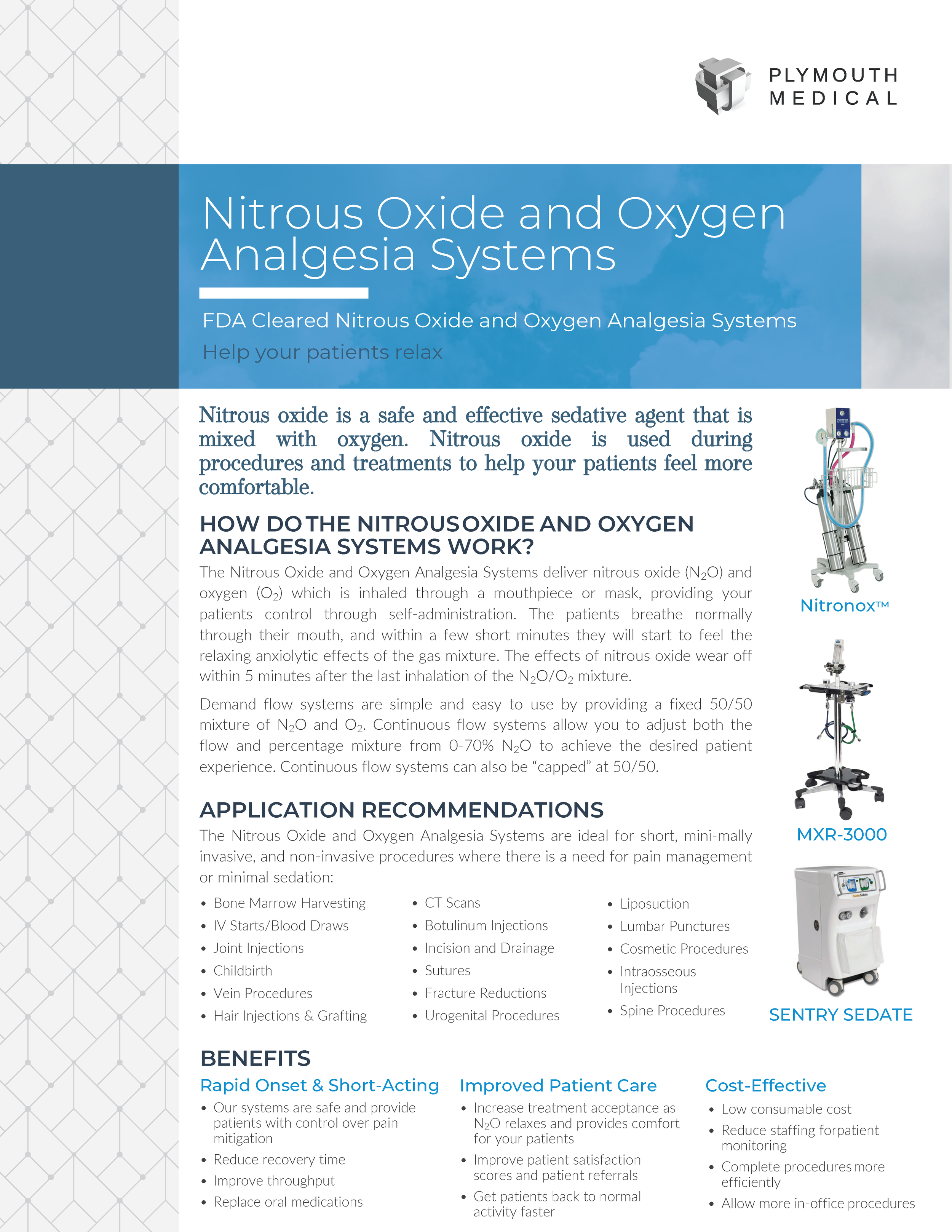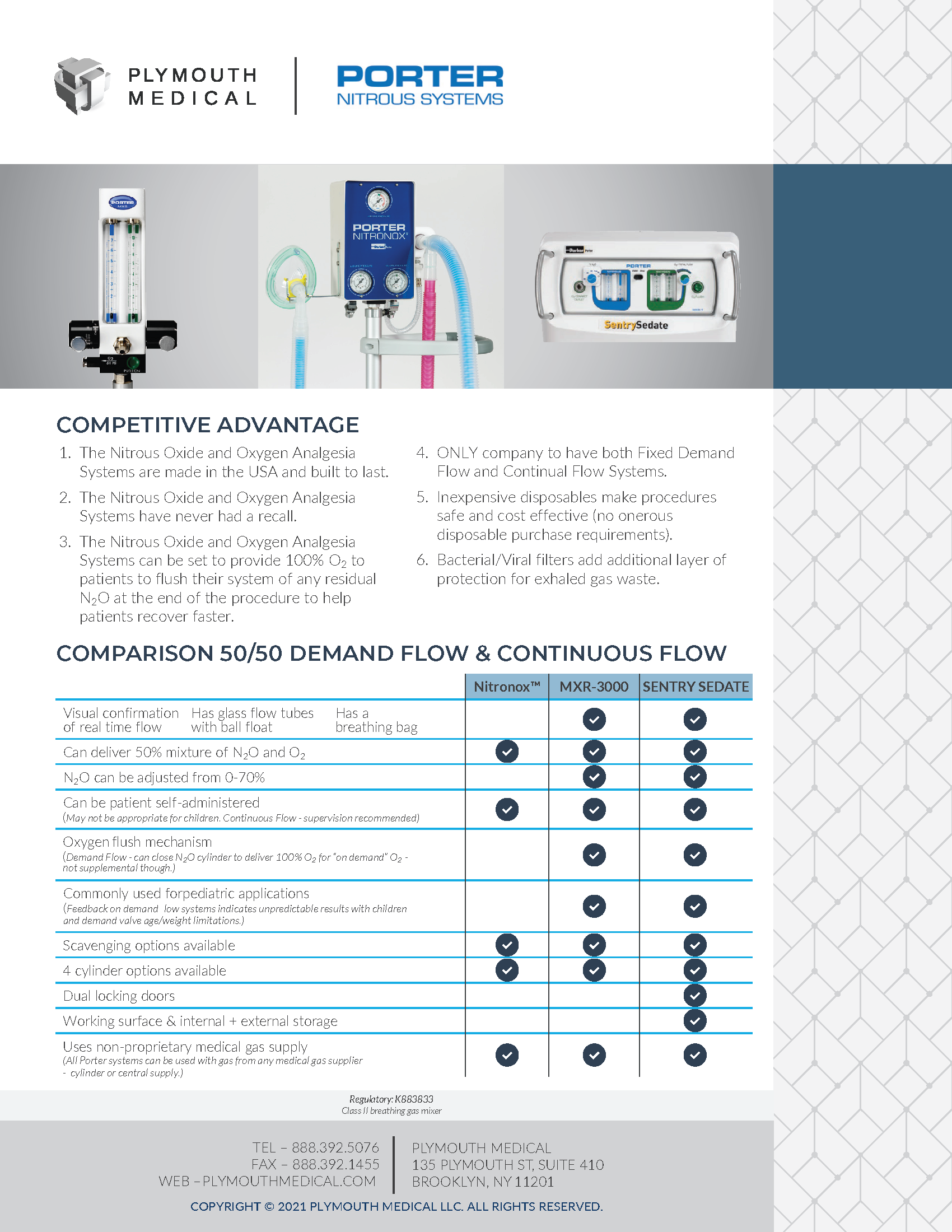PRODUCT INFORMATION
NITROUS MONITORING BADGES
SCAVENGING SYSTEM
PRODUCT VIDEO
RESOURCES
NITRONOX™
MXR-3000
SENTRY SEDATE
FREQUENTLY ASKED QUESTIONS
-
Nitrous oxide has been used for over 150 years* and has a longstanding safety record. When the Nitrous Oxide and Oxygen Analgesia System device is used – patients are awake (conscious), responsive, and breathing on their own.
* Nitrous Oxide for the Management of Labor Analgesia. AANA Journal, February 2018, Vol. 86, No. 1
-
Oxygen fail-safe preventing flow of nitrous oxide without oxygen (system will not work without oxygen)
Diameter indexed gas line connections (can’t cross connect gas hoses)
Pin-Indexed cylinder regulators (can’t cross connect regulators to cylinders)
Patient has control over self-administration (patient can stop inhaling nitrous oxide/oxygen mixture at any point)
Nitrous oxide regulator check valve for 2-cylinder cart (when removing N2O regulator to change cylinders, check valve prevents flow back out into the room from the hose and device)
Audible alarm for mixture pressure failure
Ability to secure / lock out the system
Visual pressure gauges for real time visual confirmation of gas and mixture supply (NitronoxTM only) / Visual flow tubes for real time confirmation of gas and mixture supply (Continuous Flow Systems only)
Oxygen enrichment feature increases O2% if repetitive pattern of shallow breathing (NitronoxTM only)
Dual seal diaphragm block reduces risk for leak or failure (NitronoxTM only)
-
No, neither N2O or O2 are flammable. However, they are both oxidizers which support combustion. If you have a fuel source, heat source and add an oxidizer – there is potential for hazard. If you are utilizing lasers for medical aesthetic procedures, contact the laser manufacturer for recommendations on the use of nitrous oxide and oxygen
-
Nitrous oxide is a “drug” with contraindications for use. There are also occupational concerns and risks to be aware of. Contraindications are very well documented and easy to assess. Occupational risks can be monitored and managed effectively. Additional risks could include combining N2O / O2 with other drugs and medications.
-
No, Porter nitrous oxide and oxygen systems provide patients with minimal conscious sedation. Patients will be awake and able to respond to commands.
-
The most common side effects are dizziness, nausea, and vomiting. These side effects can be quickly reversed by having the patient remove the mask/mouthpiece and breathe room air.
-
Typically, you will not find a specific regulation saying who can administer nitrous oxide and oxygen. It is the treating clinician’s responsibility to ensure that the use of N2O / O2 are within their scope of practice. You should review guidelines from your governing body or state medical board. What you would want to look for is whether it is within your scope of practice to administer pain management medications, minimal conscious sedation, anxiolysis, analgesia, etc. If the answer is yes, N2O / O2 should be no different. For the most part, use of nitrous oxide and oxygen fall under the same umbrella as administering a local anesthetic.
-
In most cases the answer is no – as you are already covered for pain management, minimal sedation, analgesia, etc. That said, the treating clinician may wish to notify your malpractice carrier if you have concerns.
-
Typically, you will not see a regulation specific to the use of nitrous oxide and oxygen for physicians or nurses. This falls under the same umbrella as utilizing pain medications, local anesthetics, analgesia, and minimal sedation.
-
Yes, the patient should never be left alone when nitrous oxide is being used.
-
As with the use of any pain medication, there is risk that a patient may be unsteady, light-headed or dizzy which could be a fall risk. It is recommended that the patient remains seated or lying down for the duration of the procedure. Allow the patient to recover for 5-10 minutes following the discontinuation of nitrous oxide and oxygen.
-
There are currently no CPT medical codes for the use of nitrous oxide. Some physicians will choose to charge an out of pocket fee - It is not uncommon to see cash fees range from $50 to $150. Conversely, physicians may also consider using Nitrous Oxide and Oxygen Analgesia Systems as a marketing tool to help assist with attracting patients and choose to offer it at no charge.
-
The onset of the effects of nitrous oxide vary from patient to patient. Effects can be felt in as little as 30 seconds or it could take several minutes. For the fastest onset, make sure the patient keeps the mask securely on their face. Once the patient stops inhaling the gas mixture, it will be completely out of their system within 5-10 minutes*. They will start feeling back to normal almost immediately.
* Nitrous Oxide for the Management of Labor Analgesia. AANA Journal, February 2018, Vol. 86, No. 1
-
No. Nitrous oxide and oxygen does not eliminate pain. This is important for educating patients and setting expectations. This will also not replace a local anesthetic (if required). Nitrous oxide is intended to take the edge off, help the patient relax, make them more comfortable, distract them, and reduce anxiety. This is not something you would use for extremely painful procedures or procedures where you need the patient to not be able to move.
-
Most will say it makes them feel relaxed, arms and legs feel light, tingling in extremities (hands / feet), floating feeling, sinking into a chair feeling, etc.
-
Nitrous oxide affects each patient differently. The majority of patients will experience the calming and relaxing effects of the nitrous oxide but there may be small set of patients that will not feel these effects. It is important to set the expectations for your patients and explain what nitrous oxide is able to provide - it helps to relax and reduce anxiety but does not eliminate pain. If you are looking for more control over the patient experience, the continuous flow systems would be a good option. The continuous flow systems allow you to adjust both the flow and percentage mixture between 0-70% nitrous oxide as opposed to the demand flow system which provides a fixed 50:50 mixture. This gives you the option to increase the N2O percentage should a patient not feel the effects of nitrous oxide or reduce the N20 percentage if a patient is feeling that the nitrous oxide effects are too strong.
-
The effects of nitrous oxide wear off very quickly, so the patient will need to utilize nitrous oxide and oxygen to maintain comfort during the procedure. If your patient is using the nitrous oxide during a laser procedure, contact the laser manufacturer for recommendations.
-
This is dependent on the procedure performed, other medications administered, etc. The effects of nitrous oxide and oxygen are completely out of the patient’s system within a few minutes. It is reasonable that a patient can safely go home about 10 minutes after ceasing use of nitrous oxide and oxygen (assuming all other discharge criteria were met).
-
Nitrous oxide is a medical gas, and OSHA has guidelines for workplace safety. The main concern is occupational exposure during frequent and/or long term use of nitrous oxide. Depending on duration of use and frequency of use, this may or may not be an area of concern for you and your staff. You should be educated and aware of potential risks and how to manage them. You can easily monitor exposure by periodically wearing nitrous oxide dosimeter testing badges that will verify the parts per million (PPM) of exposure.
-
Scavenging is the term for the removal of exhaled waste gases through a vacuum system and outside of the building. Nitrous oxide is not metabolized by the patient so amount of gas the patient breathes in is roughly the same that is exhaled out. There is no law or regulation mandating the use of scavenging systems. OSHA has standards of care with regard to use of medical gas and provides recommendation on nitrous oxide exposure limits. Aside from scavenging you can lower exposure levels by having good room air circulation, fans, open windows, not using in confined spaces, avoiding direct contact, etc. If you are unable to maintain levels of exposure below recommended levels, scavenging should be utilized.
-
The gas itself is available from most medical gas suppliers. There are large national suppliers like Praxair® (www.praxair.com) and Airgas® (www.airgas.com) – and smaller regional / local ones. If you have a supplier for oxygen – more than likely you will have access to nitrous oxide. You should shop around as suppliers will have various fees and charges added on. You will need to source size “E” cylinders with a “standard post valve” (not cylinders with integrated regulators). You should order enough gas so that you have 1 of each gas for use as well as a few spare cylinders of each gas on hand. You will go through more O2 vs. N2O as there is more N2O in one cylinder. O2 = 625 Liters, N2O = 1500 Liters. A good question to ask the gas supplier – how long will it take for delivery after you order? If it is a longer period of time, factor that in as you may want to hold additional reserve cylinders.
-
A full O2 cylinder will last approximately 2 hours of continual use. A full N2O cylinder will last about 6 hours of continual use.
-
O2 is a true gas and as it is used you will see the gauge move. A full O2 cylinder is 2000 psi, half full = 1000 psi, etc. N2O is in the cylinder as a liquid, and as it is released turns into a gas. Because of this, it maintains the same amount of pressure in the cylinder right up until it is just about empty (similar to a propane cylinder for a gas grill). A full cylinder of N2O is 750 psi, a half full cylinder of N2O is 750 psi, and a quarter full cylinder of N2O is 750 psi. You can’t look at the gauge and tell how much is left. This is why you should keep an estimate / track of use and have a spare(s) reserve on hand. The only way to know how much is in an N2O cylinder is to weigh it before and after use (which is not practical). Remember that you will get about 6 hours of use – so it should last for quite a few patients. Cylinders can be swapped out quickly and takes less than 2 minutes to complete.




